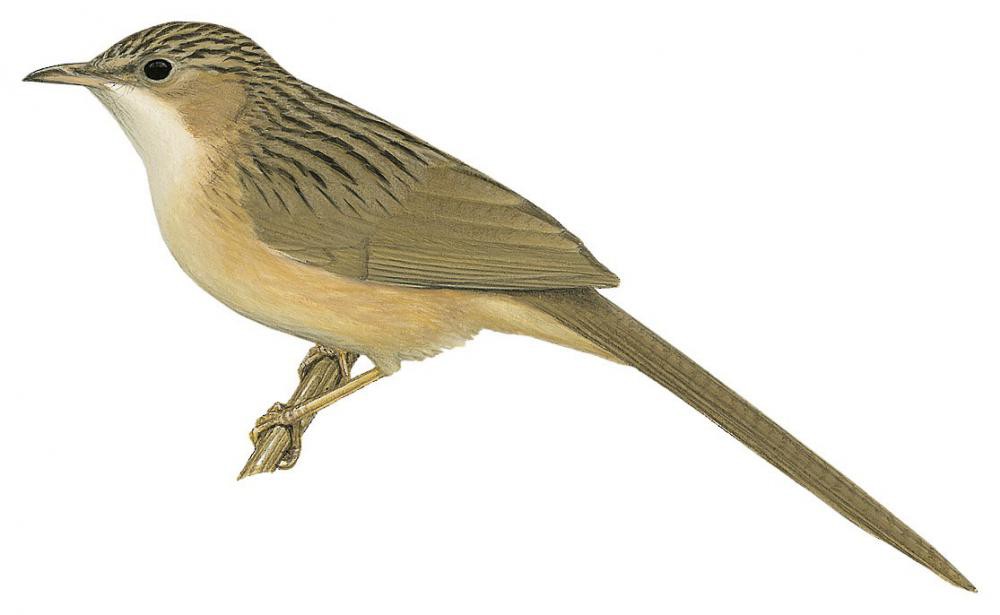Common Babbler / Turdoides caudata

Common Babbler
SCI Name:
Protonym: Cossyphus caudatus Dict.Sci.Nat. 29 p.268
Taxonomy: Passeriformes / Leiothrichidae / Turdoides
Taxonomy Code: combab3
Type Locality: India.
Author: Dumont
Publish Year: 1823
IUCN Status:
DEFINITIONS
TURDOIDES
(Leiothrichidae; Ϯ White-headed Babbler T. leucocephala) Genus Turdus Linnaeus, 1758, thrush; Gr. -οιδης -oidēs resembling; "Turdoides leucocephala, (Mus. Francof.) Weißköpfiger Droßling. ... Die Droßlinge (Turdoides) bilden eine von den Droßeln (Turdus) wohl zu unterscheidende Familie, die eine Menge von Arten zählt, von denen Rüppel bereits vier aus dem nördlichen Afrika eingesendet hat. Wir werden die Abbildungen und Beschreibungen von dreyen derselben in dem Atlas liefern. Auch erwarten wir duie Bekanntmachung anderer in Indien entdeckten Arten der Gattung Turdoides von Herrn Temminck, der solche zuerst aufgestellt hat." (Cretzschmar 1827); "Turdoides Cretzschmar, 1827, in Rüppell's Atlas, Vög., hft. 4, p. 6, pl. 4. Type, by monotypy, Turdoides leucocephalus Cretzschmar." (Deignan in Peters 1964, X, 331).
Var. Tordoides.
Synon. Aethocichla, Aipunemia, Crateropus, Cratopus, Ischyropodus, Layardia, Malacocircus, Malcolmia, Pengia.
turdoides
L. turdus thrush; Gr. -οιδης -oidēs resembling.
● “Both Seebohm and Saunders have used Meyer’s name Sylvia turdoides, 1815, for the Great Reed-Warbler, because, according to the first named, Linnaeus in placing the species under the genus Turdus made the definition quite misleading. Turdus arundinaceus of Linnaeus was, however, founded on Klein’s Turdus musicus palustris, which undoubtedly refers to the Great Reed-Warbler, and there can be no objection to the name, which is the oldest and has always been more or less in use” (BOU 1915) (syn. Acrocephalus arundinaceus).
● “Altogether of a much Thrush-like appearance” (Hartert 1896) (Cataponera).
● "14. COLLURICINCLE GRIVELÉ. — COLLURICINCLA TURDOIDES. ... Ce Colluricincle est originaire de Raffles-Bay. Il appartient à la section des espèces de ce genre qui est caractérisée par un bec plus large et moins comprimée. Ses couleurs et sa petite taille le rapprochent du Colluricincla brunnea Gould; il s'en isole par la coloration à peu près uniforme de la région thoraco-abdominale." (Pucheran 1853) (syn. Colluricincla parvula).
caudata / caudatus
L. caudatus tailed, having a (long/short) tail < cauda tail.
● ex “Parus caudatus” of Gessner 1555, Aldrovandus 1599, and Willughby 1676, “Long-tail’d Titmouse” of Ray 1713, and “Parus vertice albo, cauda corpore longiore” of Linnaeus 1746 (Aegithalos).
● ex “Merle vert à longue queue de Sénégal” of Brisson 1760 (Lamprotornis).
● ex “Gobe-mouche à longue queue de Madagascar” of d’Aubenton 1765-1781, pl. 248, fig. 1 (syn. Terpsiphone mutata).
● ex “Courly à col blanc de Cayenne” of d’Aubenton 1765-1781, pl. 976, and “Grand Courlis de Cayenne” of de Buffon 1770-1785 (Theristicus).
SUBSPECIES
Common Babbler (eclipes)
SCI Name: Turdoides caudata eclipes
eclipes / eclipis
Gr. εκλιπης eklipēs overlooked, deficient < εκλειπω ekleipō to pass over.
• "Chatorhea eclipes, Sp. Nov. ... The present species, a rather small and faded specimen of which, as I now believe (I have not the specimen to refer to), I figured in Lahore to Yarkand, p. 197, Pl. IX., for C. caudata seems to be better separated from this latter than huttoni, as I have hitherto failed to obtain intermediate forms." (Hume 1877) (subsp. Argya caudata).
• "RHINOMYIAS UMBRATILIS ECLIPIS, new subspecies Similar to Rhinomyias umbratilis richmondi, but decidedly smaller; upper parts rather lighter, posteriorly somewhat more tawny; sides of breast darker, more tawny; and lores less whitish. ... Tana Masa Island, Batu Islands" (Oberholser 1912) (syn. Cyornis umbratilis).
Common Babbler (caudata)
SCI Name: Turdoides caudata caudata
caudata / caudatus
L. caudatus tailed, having a (long/short) tail < cauda tail.
● ex “Parus caudatus” of Gessner 1555, Aldrovandus 1599, and Willughby 1676, “Long-tail’d Titmouse” of Ray 1713, and “Parus vertice albo, cauda corpore longiore” of Linnaeus 1746 (Aegithalos).
● ex “Merle vert à longue queue de Sénégal” of Brisson 1760 (Lamprotornis).
● ex “Gobe-mouche à longue queue de Madagascar” of d’Aubenton 1765-1781, pl. 248, fig. 1 (syn. Terpsiphone mutata).
● ex “Courly à col blanc de Cayenne” of d’Aubenton 1765-1781, pl. 976, and “Grand Courlis de Cayenne” of de Buffon 1770-1785 (Theristicus).
UPPERCASE: current genus
Uppercase first letter: generic synonym
● and ● See: generic homonyms
lowercase: species and subspecies
●: early names, variants, mispellings
‡: extinct
†: type species
Gr.: ancient Greek
L.: Latin
<: derived from
syn: synonym of
/: separates historical and modern geographic names
ex: based on
TL: type locality
OD: original diagnosis (genus) or original description (species)












